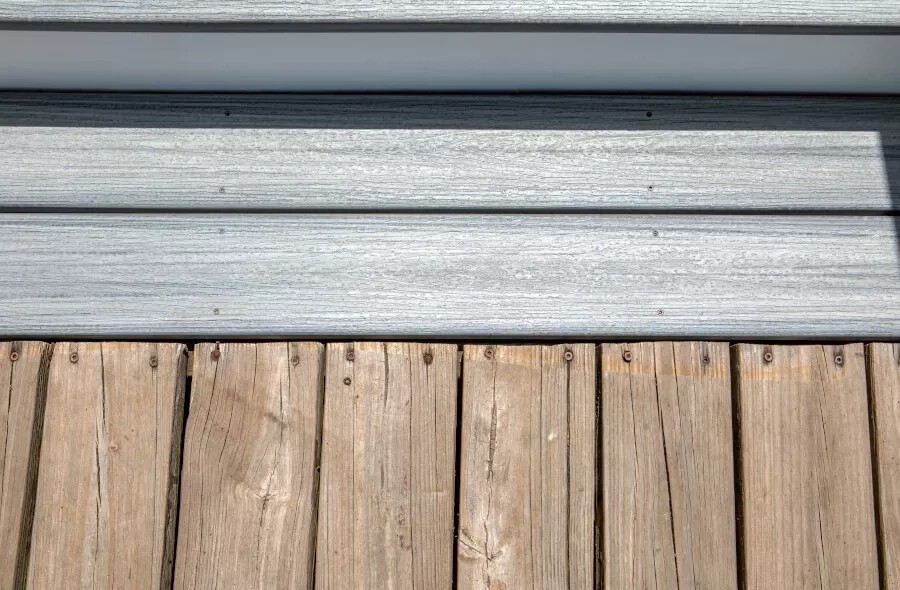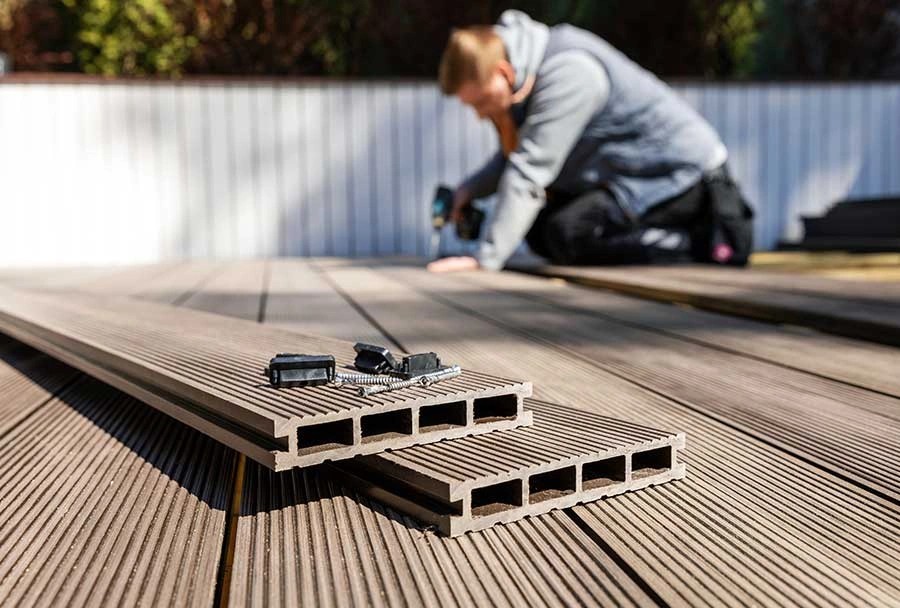How to Choose WPC Outdoor Decking That Won't Fade or Crack
May 19,2025

Looking for a deck that truly lasts? Composite decking lifespan ranges from 10 to 15 years—significantly longer than traditional wood options that often need replacement much sooner.
We've all seen it before: once-beautiful wooden decks that quickly become weathered, splintered, and discolored. Unlike conventional wood, WPC (Wood Plastic Composite) decking combines wood fibers and thermoplastics to create a superior outdoor solution. This innovative material offers exceptional resistance to moisture, humidity, and those pesky insects that love to make your deck their home.
But how long will composite decking last in real-world conditions? The answer depends largely on the quality of materials and your specific environment. The plastic component in WPC decking acts as a protective barrier against harmful UV rays, ensuring your deck maintains its vibrant appearance over time. Additionally, this remarkable material requires minimal maintenance—just occasional cleaning with soap and water, rather than the regular sealing, staining, and sanding traditional wood demands.
In this guide, we'll walk you through everything you need to know about selecting WPC decking that stays beautiful for years, without fading or cracking under pressure.
Understand What Causes Fading and Cracking

Understanding why decks deteriorate helps you make smarter choices when selecting materials. Even the best composite products can experience problems when exposed to harsh elements over time.
Sunlight and UV exposure
The sun's ultraviolet (UV) rays are the primary culprits behind deck fading and deterioration. UV radiation breaks down chemical bonds in decking materials, causing colors to fade and surfaces to degrade. For traditional wood decks, UV rays attack lignin—the component that holds wood fibers together—leading to surface deterioration. Uncapped composite decking isn't immune either; studies show UV radiation causes material discoloration, surface cracking, and reduced water resistance.
During artificial weathering tests, the color change for composite decking can reach 15-20 units under UV radiation. Furthermore, photodegradation affects materials up to 0.5mm in depth, though the degradation can occur deeper through free radical chain reactions—reaching 500-2500 μm from the surface.
Moisture and temperature changes
Water and temperature fluctuations create a destructive cycle for outdoor decking. When wood absorbs moisture, it expands; when it dries, it contracts. This constant expansion and contraction leads to warping and cracking over time.
Similarly, composite decking materials expand and contract with temperature changes, which may result in cracking, splitting, or warping if not properly installed. Research shows that exposure to high environmental humidity (93%) affects bending strength more significantly than temperature or UV exposure alone. Moreover, the rate of water absorption accelerates with increased water bath temperature.
In regions with high humidity and frequent rainstorms, decks face increased risk of moisture damage, while decks in arid climates might crack due to excessive heat and dryness. These freeze-thaw cycles—when temperatures fluctuate above and below freezing—are especially damaging, causing materials to repeatedly expand and contract.

Poor material composition
The quality of materials directly impacts how well your deck withstands environmental challenges. Lower-quality composite decks may fade, scratch, or degrade faster than premium options.
Studies show that increasing filler content in WPC leads to higher water absorption, while inadequate UV stabilizers can cause significant surface damage in just three months of natural weathering. Without proper UV absorbers, hindered amine light stabilizers (HALS), or UV-resistant coatings, composite decking becomes vulnerable to premature degradation.
The plastic component quality also affects fade resistance—decking made with high-density polyethylene (HDPE) generally exhibits better color retention than those made with lower-grade plastics. Consequently, selecting high-quality WPC materials with proper additives is critical for ensuring your deck maintains its appearance and structural integrity throughout its expected lifespan.
What Makes WPC Decking a Better Choice

WPC decking offers several advantages over traditional wooden options, making it an increasingly popular choice for outdoor spaces where durability matters.
Blend of wood fibers and plastic
The secret to WPC's exceptional performance lies in its composition. Most composite decking consists of approximately 70% wood particles and 30% recycled plastic, typically high-density polyethene. This innovative combination creates a material that captures wood's natural beauty with plastic's remarkable durability.
Unlike pure wood or plastic alone, this blend creates a unique synergy - the wood fibers provide structural stability and a natural appearance, whereas the plastic component delivers weather resistance and longevity. Notably, many manufacturers use recycled materials in production, with some boards containing up to 85% recycled content.
This composition prevents the common problems that plague wooden decks: splitting, splintering, and warping. In fact, the structural integrity of quality WPC decking remains intact even after years of exposure to environmental stressors.
Built-in UV resistance
Sun exposure destroys traditional decking, yet quality WPC products incorporate specialized technology to combat this. Many manufacturers include UV absorbers, light stabilizers, and protective polymer capping that shields boards from solar radiation.
The effectiveness of these UV-resistant features varies between products. Higher-end composite decking often features a four-sided protective polymer cap (even in the grooves) made without wood fibers, providing superior sun resistance. These specialized caps function as barriers against UV rays, significantly reducing color fading and surface deterioration.
Laboratory testing confirms these benefits - one manufacturer's test report demonstrated remarkably low color change values (ΔE*ab) despite extended UV exposure.

Moisture and insect resistance
Perhaps WPC's most significant advantage is its exceptional resistance to moisture-related issues:
- Will not rot, swell, or warp when exposed to rain or humidity
- Features low water absorption rates - premium capped composite decking absorbs as little as 0.13% moisture
- Resists mold and mildew growth due to moisture-resistant properties
Beyond water resistance, WPC decking offers complete protection against insects. Since the plastic component makes the material inedible, termites and other wood-boring pests cannot damage composite boards. This insect-proof quality extends the composite decking lifespan considerably compared to traditional wood options, with quality WPC decking lasting between 25-30 years under normal conditions.
How to Choose WPC Decking That Lasts
Selecting the right WPC decking requires careful consideration of several key factors that directly impact its resistance to fading and cracking. With proper research, you can find products that maintain their beauty for decades.
Check for UV-resistant coatings
The first defense against fading is a quality protective coating. Look for decking with co-extrusion technology that includes a 360-degree outer polymer shell, which physically bonds with the core material to create superior resistance against UV damage. This technology significantly reduces color fading and prevents the surface degradation that plagues lesser products.
Premium WPC decking often features specialized coatings containing zinc nano-particles, with over 30 trillion particles per square inch that reflect damaging UV rays. These particles function similarly to sunscreen, creating a barrier that extends color retention and prevents premature aging.
Look for high-density core materials
The core composition directly affects durability. High-density cores with modified HDPE (High-Density Polyethylene) offer exceptional resistance to warping and cracking. For maximum durability, choose products with advanced co-extrusion technology where the protective shell bonds completely with a high-density core.
Some manufacturers have developed proprietary core technologies like "Strong Core" that enhance moisture resistance, essential for preventing internal deterioration over time.
Choose brands with proven durability
Reputation matters tremendously in this industry. Established brands often use superior materials and manufacturing processes. Companies with 10+ years in production typically offer more reliable products. Leading manufacturers have developed technologies like ColorWatch100® for enhanced UV protection and DiamondDefense™ finishes for superior scratch resistance.
Compare warranties and certifications
Warranty length directly reflects manufacturer confidence in their product. Premium WPC decking typically comes with:
- 25-50 year residential warranties for high-end products
- 5-15 year commercial warranties, depending on quality
- Specific fade and stain warranties apart from structural coverage
Certified products with ISO International Standards compliance provide additional assurance of quality. Remember that genuine high-performance composite decking might cost more initially ($3-$7 per square foot), but its extended lifespan makes it more economical long-term.
Maintaining WPC Decking for Long-Term Use
Proper maintenance dramatically extends your deck's life and preserves its appearance. Even with WPC's inherent durability, simple care routines help prevent common issues.
Simple cleaning routines
Regular cleaning prevents dirt buildup that can lead to staining and deterioration. Firstly, sweep away leaves, dirt, and debris frequently to keep surfaces clear. For normal cleaning, warm soapy water and a soft bristle brush are typically sufficient. When cleaning:
- Work in small, manageable areas, rinsing thoroughly before moving on
- Clean along the grain direction to remove debris from expansion gaps
- Use a garden hose for rinsing (pressure washers should be limited to 1,500-3,100 PSI with fan tip nozzle)
Most manufacturers recommend cleaning composite decking at least twice yearly, ideally during mild weather when temperatures aren't extreme.
Avoiding harsh chemicals
Harsh cleaners can damage WPC decking's protective layer. Avoid:
- Bleach, ammonia, and acetone-based products
- Composite deck cleaners specified for different materials
- Abrasive cleaning tools like wire brushes
Instead, use mild detergents or specialized non-bleaching cleaners designed specifically for WPC materials. For tough stains like mold, equal parts water and white vinegar often prove effective.
Inspecting for wear and tear annually
Annual inspections help catch minor issues before they become major problems. During inspection, check for:
- Loose or damaged fasteners that need securing
- Signs of bowing or sagging boards
- Surface damage requiring attention
Pay extra attention to areas where water might pool or where furniture sits for extended periods.
How long will composite decking last?
With proper maintenance, high-quality WPC decking typically lasts 25-30 years, substantially longer than traditional wood's 10-15 year lifespan. Several factors influence composite decking lifespan:
- Regular cleaning prevents mold and premature aging
- Using protective mats under grills and heavy furniture reduces wear
- Proper drainage prevents standing water issues
- Addressing minor damage promptly prevents deterioration
Indeed, the composite decking lifespan directly correlates with maintenance quality—neglected decks might last only 10-15 years, whereas well-maintained ones can exceed three decades of beautiful, functional use.
Conclusion
Choosing the right WPC decking ultimately makes all the difference between a disappointing investment and a stunning outdoor space that stands the test of time. Throughout this guide, we've highlighted how composite decking lifespan far exceeds traditional wood options when you select quality materials with proper protection features.
Above all, understanding what causes degradation helps you make better purchasing decisions. UV rays, moisture fluctuations, and temperature changes represent the primary threats to any decking material. However, premium WPC products with specialized UV-resistant coatings and high-density cores effectively combat these challenges.
While initial costs may seem higher than traditional wood, the long-term value becomes undeniably clear. Quality composite decking requires significantly less maintenance—no sanding, staining, or sealing—and lasts 25-30 years compared to wood's 10-15 year lifespan. Additionally, the minimal upkeep consists of simple cleaning with mild soap and occasional inspections for wear.
The blend of wood fibers and plastic creates a remarkably resilient product that won't fall victim to insect damage, rot, or warping. Consequently, your outdoor space remains beautiful and functional year after year without the constant worry of deterioration.
Remember that warranties often reflect manufacturer confidence in their products. Therefore, brands offering extended 25-50 year coverage likely produce superior materials worth the investment. By selecting well-established manufacturers, checking for comprehensive UV protection, and maintaining your deck properly, you'll enjoy decades of outdoor living on a surface that maintains its beauty despite whatever weather comes your way.
Related Posts
Are you looking for a reliable environmentally friendly composite flooring manufacturer?
We can quickly provide customers with market analysis, technical support and customized services.






